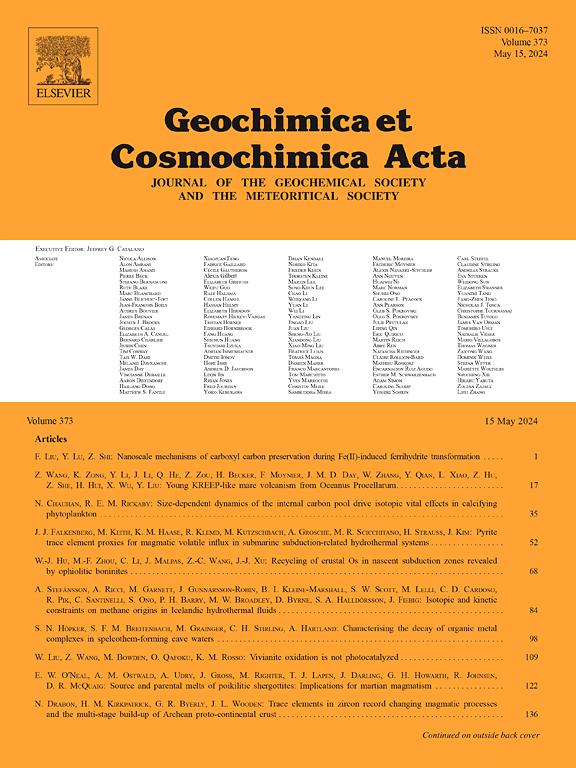Significant calcium isotope fractionation driven by partial dissolution of subducting carbonate in slab-derived fluids
IF 5
1区 地球科学
Q1 GEOCHEMISTRY & GEOPHYSICS
引用次数: 0
Abstract
The burial of carbon from Earth’s surface to its deep interior is vital for sustaining the planet’s habitability, however, uncertainties in the dissolution behavior of subducting carbonates make the efficiency of such a process debatable. In this study, we investigate the dissolution behavior of carbonates in subduction zones by analyzing Ca isotope compositions of ultrahigh-pressure (UHP) marbles from the Sulu orogen, China. Our results reveal a δ44/42Ca range that extends from protolith-like values (∼0.46 ‰) to significantly lighter ones (0.19 ‰). This variation, correlating positively with 87Sr/86Sr(i) (0.7038–0.7075), indicates a role of infiltration of external fluids, likely derived from dehydration during the amphibolite to eclogite transition of mafic lithologies with variably low 87Sr/86Sr(i). Simulations on fluid-carbonate interaction processes at the constrained conditions illustrate that Ca isotope variations of marbles were dominantly governed by dissolution. With heavy Ca isotopes being preferentially enriched in the fluids in equilibrium, δ44/42Ca of the residual carbonates could have decreased progressively with increasing degrees of dissolution. Utilizing a Rayleigh fractionation model, we estimate that negligible dolomitic marbles versus a substantial proportion—approximately 76 ± 15 %—of Ca-rich marbles have undergone dissolution. Our study illustrates that Ca-rich carbonates can be efficiently dissolved if slab-derived fluids are present, even at continental subduction zones where the slabs are commonly considered to be “dry”. This dissolution process has transferred an isotopically mantle-like Ca flux upward, and left behind residual calcium carbonate with notably lighter δ44/42Ca. Our findings provide evidence for the contrast dissolution behaviors of calcium versus magnesium carbonates in the subduction channel, and help to explain why light Ca isotope anomalies are commonly identified among mantle-derived magmas far away from magmatic arcs.
在板块衍生流体中,俯冲碳酸盐的部分溶解驱动了显著的钙同位素分馏
从地球表面到其内部深处的碳埋藏对于维持地球的宜居性至关重要,然而,俯冲碳酸盐溶解行为的不确定性使得这一过程的效率存在争议。本文通过对苏鲁造山带超高压大理岩钙同位素组成的分析,探讨了俯冲带碳酸盐岩的溶蚀行为。结果表明,δ44/42Ca的范围从类似原岩的值(~ 0.46‰)扩展到明显较轻的值(0.19‰)。这种变化与87Sr/86Sr(i)正相关(0.7038-0.7075),表明外部流体的渗透作用,可能是由于87Sr/86Sr(i)变低的基性岩性中角闪岩向榴辉岩转变过程中的脱水作用。在约束条件下流体-碳酸盐相互作用过程的模拟表明,大理岩的Ca同位素变化主要受溶蚀作用的控制。由于重Ca同位素在平衡流体中优先富集,残余碳酸盐的δ44/42Ca可能随着溶蚀程度的增加而逐渐减小。利用瑞利分选模型,我们估计白云岩大理岩的溶蚀作用可以忽略不计,而富钙大理岩的溶蚀作用占很大比例(约76±15%)。我们的研究表明,如果板块衍生流体存在,富钙碳酸盐可以有效地溶解,即使在板块通常被认为是“干燥”的大陆俯冲带。这一溶蚀过程向上转移了一个同位素似地幔的钙通量,并留下了δ44/42Ca较轻的残余碳酸钙。我们的发现为钙和镁碳酸盐在俯冲通道中的溶蚀行为对比提供了证据,并有助于解释为什么轻钙同位素异常通常在远离岩浆弧的幔源岩浆中被发现。
本文章由计算机程序翻译,如有差异,请以英文原文为准。
求助全文
约1分钟内获得全文
求助全文
来源期刊

Geochimica et Cosmochimica Acta
地学-地球化学与地球物理
CiteScore
9.60
自引率
14.00%
发文量
437
审稿时长
6 months
期刊介绍:
Geochimica et Cosmochimica Acta publishes research papers in a wide range of subjects in terrestrial geochemistry, meteoritics, and planetary geochemistry. The scope of the journal includes:
1). Physical chemistry of gases, aqueous solutions, glasses, and crystalline solids
2). Igneous and metamorphic petrology
3). Chemical processes in the atmosphere, hydrosphere, biosphere, and lithosphere of the Earth
4). Organic geochemistry
5). Isotope geochemistry
6). Meteoritics and meteorite impacts
7). Lunar science; and
8). Planetary geochemistry.
 求助内容:
求助内容: 应助结果提醒方式:
应助结果提醒方式:


